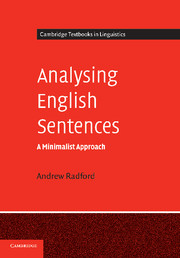4 - Head movement
Summary
Overview
So far, we have examined a range of syntactic structures which are derived by a series of merger operations. We now go on to look at structures whose derivation involves not only merger but also a specific type of movement operation called head movement. In this chapter, we focus mainly on two specific types of head movement operation, one which affects auxiliaries in present-day English, and another which affected main verbs in earlier stages of English; we also look briefly at how head movement can apply to nouns.
T-to-C movement
In chapters 2 and 3, we saw that complementisers are positioned in front of subjects in the clauses they introduce. More specifically, I suggested that complementisers head a separate projection in clauses which I termed a complementiser phrase/CP, with the head C position of CP being filled by a complementiser like that, for, if. However, complementisers are not the only kinds of word which can precede subjects in clauses. As we saw in the brief discussion of questions in §3.7, auxiliaries can also precede subjects in yes-no questions such as Do you feel like a Coke?
- Type
- Chapter
- Information
- Analysing English SentencesA Minimalist Approach, pp. 143 - 182Publisher: Cambridge University PressPrint publication year: 2009

